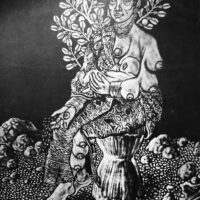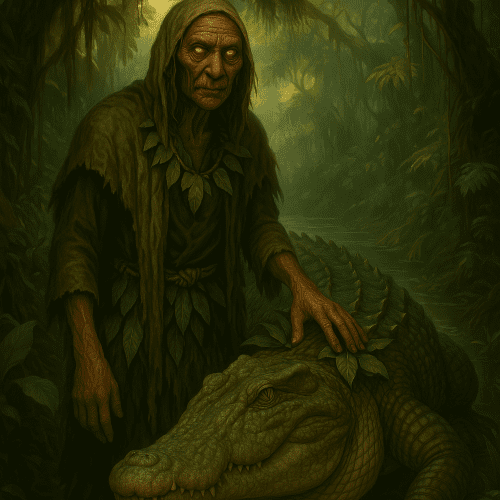Badadum : The Philippine Psychopomp
Listen
At a glance
| Description | |
|---|---|
| Origin | Philippine Mythology |
| Classification | Spirits |
| Family Members | N/A |
| Region | Philippines |
| Associated With | Death, Spirits |
Badadum
Introduction
In the heart of Philippine mythology, particularly among the Visayan and Waray peoples, Badadum stands as a quiet but powerful figure. Revered not for thunderous battles or celestial drama, Badadum holds a more sacred and introspective role—the guide of souls to the afterlife. Unlike other deities who usher spirits across rivers or judge them, Badadum’s domain is uniquely tender and symbolic. He gathers the departed’s family at the river’s mouth, where this sacred reunion helps the soul pass peacefully into the next world. His name, often translated as “happy one who gave fertility and happiness,” reflects not only his divine function but the emotional richness of his myths. He is not just a gatekeeper of death but a gentle usher of continuity, family bonds, and spiritual completion.
Physical Traits
Descriptions of Badadum’s appearance are rare and shrouded in oral tradition rather than visual iconography. He is often conceptualized more as a presence than a person—a liminal force rather than a deity with a fixed form. Some accounts from local folklore paint him as a figure cloaked in fog, standing where the land kisses the river. He might take the form of a man, but just as easily appear as a gust of wind or a shifting ripple on the water. His form, like the moment of death itself, is transitional—fleeting, comforting, and profound. He is not meant to frighten, but to console, embodying the final passage in a soul’s earthly journey.
Family
While many deities are characterized by lineage and mythic parentage, Badadum’s narrative stands apart. His family ties are not biological but spiritual. In the mythic structure of the Visayas, he is associated with other soul-guiding entities such as Magyan and Sumpoy, though his role remains distinct. Where Magyan takes souls across rivers and Sumpoy leads them into sacred mountain realms, Badadum’s place is at the beginning of that journey. His connection to the dead’s family is symbolic, creating a space for communal farewell rather than familial hierarchy. He is a spiritual intermediary—not between gods and mortals, but between loved ones separated by life and death.
Other names
The deity is also referred to in some historical texts as Si Buranen, a name found in early Spanish colonial writings like Francisco Alcina’s Historia de Las Islas e Indios Bisayas (1668). While this alternate name does not appear widely across all regions, it highlights the syncretic nature of pre-colonial Filipino spirituality, where deities often went by different names depending on local dialects or priestly traditions. Although the name Badadum has endured more clearly in contemporary recognition, both titles point to a deity deeply involved in maintaining cosmic order through compassionate guidance.
Powers and Abilities
Badadum’s abilities are not about domination or spectacle—they are rooted in ritual, memory, and the sacred act of letting go. His primary power is the summoning of the deceased’s kin to meet at the river’s edge. This metaphysical gathering serves both the dead and the living: it allows the soul to cross over without fear, and gives the family closure through a final moment of spiritual connection. In Visayan belief systems, the river is not just water—it is a boundary, a mirror, a place of truth. By calling loved ones to this meeting point, Badadum becomes a guardian of thresholds, where time, life, and emotion converge. Unlike other deities who challenge or test souls, he comforts and completes their journey, ensuring that no one crosses into the afterlife alone.
Modern Day Influence
The legacy of Badadum has quietly threaded its way into modern Filipino life, particularly in how death is honored in rural communities. Rituals that take place near rivers, or customs that involve symbolic water elements during wakes and funerals, echo the mythos of Badadum. These traditions, passed down generations without always naming the deity, still carry his influence.
His quiet role has also found new relevance in creative reinterpretations. A short film titled Badadum, produced in recent years, draws directly from indigenous Waray beliefs, showcasing the deity as a central figure in a tale of loss and remembrance. The film, while fictional, serves as cultural preservation—highlighting how Badadum’s story continues to inspire visual art, performance, and storytelling. He is slowly reemerging in graphic novels, indie cinema, and even in speculative fiction where ancient deities are reimagined in contemporary worlds. This renewed interest reflects a broader movement in the Philippines to reconnect with ancestral heritage and reclaim mythologies obscured by colonization and modernity.
In the digital age, artists and folklorists alike are using platforms like social media, illustration, and generative AI tools to visualize and interpret Badadum’s presence. His story is particularly resonant in a world increasingly disconnected from communal rituals of mourning. As people seek new ways to understand grief and transition, Badadum offers an ancient yet timeless metaphor for compassion at the edge of life.
Related Images
Source
Anderson, G. H. (Ed.). (1969). Studies in Philippine Church History. Cornell University Press.
Demetrio, F. (1968). The Village, Early Cagayan de Oro in Legend and History. Xavier University.
Demetrio, F. (1968). Towards a Survey of Philippine Folklore and Mythology. Ateneo de Manila University Press.
Scott, W. H. (1969). A Critical Study of the Prehispanic Source Materials for the Study of Philippine History. University of Santo Tomas, Unitas Filipinian Series.
The Aswang Project. (2016, February 6). Visayan Deities in Philippine Mythology. Retrieved from https://www.aswangproject.com/visayan-deities-in-philippine-mythology/
The Aswang Project. (2017, March 9). Psychopomps (Death Guides) of the Philippines. Retrieved from https://www.aswangproject.com/psychopomps-philippines/
The Pinay Writer. (2024, May 7). The Bisayan Deities: Who Were the Gods & Goddesses?. Retrieved from https://thepinaywriter.com/the-bisayan-deities-who-were-the-gods-goddesses/
Frequently Asked Questions
What is lorem Ipsum?
I am text block. Click edit button to change this text. Lorem ipsum dolor sit amet, consectetur adipiscing elit. Ut elit tellus, luctus nec ullamcorper mattis, pulvinar dapibus leo.
What is lorem Ipsum?
I am text block. Click edit button to change this text. Lorem ipsum dolor sit amet, consectetur adipiscing elit. Ut elit tellus, luctus nec ullamcorper mattis, pulvinar dapibus leo.
What is lorem Ipsum?
I am text block. Click edit button to change this text. Lorem ipsum dolor sit amet, consectetur adipiscing elit. Ut elit tellus, luctus nec ullamcorper mattis, pulvinar dapibus leo.
What is lorem Ipsum?
I am text block. Click edit button to change this text. Lorem ipsum dolor sit amet, consectetur adipiscing elit. Ut elit tellus, luctus nec ullamcorper mattis, pulvinar dapibus leo.
What is lorem Ipsum?
I am text block. Click edit button to change this text. Lorem ipsum dolor sit amet, consectetur adipiscing elit. Ut elit tellus, luctus nec ullamcorper mattis, pulvinar dapibus leo.











